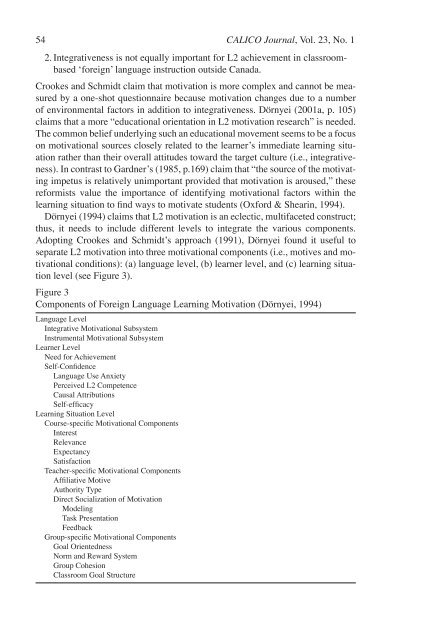The Role of Students' Attitudes and Motivation in Second ... - CALICO
The Role of Students' Attitudes and Motivation in Second ... - CALICO
The Role of Students' Attitudes and Motivation in Second ... - CALICO
Create successful ePaper yourself
Turn your PDF publications into a flip-book with our unique Google optimized e-Paper software.
54 <strong>CALICO</strong> Journal, Vol. 23, No. 1<br />
2. Integrativeness is not equally important for L2 achievement <strong>in</strong> classroombased<br />
‘foreign’ language <strong>in</strong>struction outside Canada.<br />
Crookes <strong>and</strong> Schmidt claim that motivation is more complex <strong>and</strong> cannot be measured<br />
by a one-shot questionnaire because motivation changes due to a number<br />
<strong>of</strong> environmental factors <strong>in</strong> addition to <strong>in</strong>tegrativeness. Dörnyei (2001a, p. 105)<br />
claims that a more “educational orientation <strong>in</strong> L2 motivation research” is needed.<br />
<strong>The</strong> common belief underly<strong>in</strong>g such an educational movement seems to be a focus<br />
on motivational sources closely related to the learner’s immediate learn<strong>in</strong>g situation<br />
rather than their overall attitudes toward the target culture (i.e., <strong>in</strong>tegrativeness).<br />
In contrast to Gardner’s (1985, p.169) claim that “the source <strong>of</strong> the motivat<strong>in</strong>g<br />
impetus is relatively unimportant provided that motivation is aroused,” these<br />
reformists value the importance <strong>of</strong> identify<strong>in</strong>g motivational factors with<strong>in</strong> the<br />
learn<strong>in</strong>g situation to f<strong>in</strong>d ways to motivate students (Oxford & Shear<strong>in</strong>, 1994).<br />
Dörnyei (1994) claims that L2 motivation is an eclectic, multifaceted construct;<br />
thus, it needs to <strong>in</strong>clude different levels to <strong>in</strong>tegrate the various components.<br />
Adopt<strong>in</strong>g Crookes <strong>and</strong> Schmidt’s approach (1991), Dörnyei found it useful to<br />
separate L2 motivation <strong>in</strong>to three motivational components (i.e., motives <strong>and</strong> motivational<br />
conditions): (a) language level, (b) learner level, <strong>and</strong> (c) learn<strong>in</strong>g situation<br />
level (see Figure 3).<br />
Figure 3<br />
Components <strong>of</strong> Foreign Language Learn<strong>in</strong>g <strong>Motivation</strong> (Dörnyei, 1994)<br />
Language Level<br />
Integrative <strong>Motivation</strong>al Subsystem<br />
Instrumental <strong>Motivation</strong>al Subsystem<br />
Learner Level<br />
Need for Achievement<br />
Self-Confidence<br />
Language Use Anxiety<br />
Perceived L2 Competence<br />
Causal Attributions<br />
Self-efficacy<br />
Learn<strong>in</strong>g Situation Level<br />
Course-specific <strong>Motivation</strong>al Components<br />
Interest<br />
Relevance<br />
Expectancy<br />
Satisfaction<br />
Teacher-specific <strong>Motivation</strong>al Components<br />
Affiliative Motive<br />
Authority Type<br />
Direct Socialization <strong>of</strong> <strong>Motivation</strong><br />
Model<strong>in</strong>g<br />
Task Presentation<br />
Feedback<br />
Group-specific <strong>Motivation</strong>al Components<br />
Goal Orientedness<br />
Norm <strong>and</strong> Reward System<br />
Group Cohesion<br />
Classroom Goal Structure
















